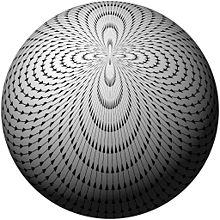Sentence of the hedgehog
The sentence of the hedgehog , also hedgehog sentence or sentence of the combed hedgehog , English Hairy ball theorem , is a result of the mathematical sub-area of topology . Some authors also call this theorem Poincaré-Brouwer , because Luitzen Egbertus Jan Brouwer was able to prove it in 1912 using Poincaré's theorem. In physics , the sentence is also linked to the problem of global wind .
Formulation of the hedgehog set
- On a sphere there is a tangential , continuous , nowhere vanishing vector field if and only if is odd.
Memorandum
The fact that such a tangential, constant and nowhere vanishing vector field does not exist for the 2-sphere, i.e. for the surface of a three-dimensional space sphere, is clearly summarized in the following motto :
- Every constantly combed hedgehog has at least one bald spot.
Such a bald spot corresponds to a “bald spot”, that is, a zero point of the continuous tangential vector field. This motto also explains the name “Hedgehog set”, which goes back to David Hilbert .
Interpretation in physics
If one interprets the proposition of the hedgehog in the physical sense, then in principle wind cannot blow everywhere on earth at the same time - there must always be calm spots on the surface of a three-dimensional spherical planet (hence the term "problem of global wind" ). A flat surface, on the other hand, can be combed continuously without any bald spots. This also applies to a torus .
generalization
The hedgehog theorem follows directly from the following more general theorem, which some authors also refer to as Poincaré-Brouwer's theorem:
- For each and for each continuous mapping there is one and one with .
The phrase about the hedgehog can also be derived directly from Poincaré-Hopf's phrase .
Analytical context
John Milnor gave an elementary analytical proof of the hedgehog theorem in 1978 and at the same time showed that Brouwer's Fixed Point Theorem can be traced back directly to him.
swell
- R. Abraham, Jerrold E. Marsden , T. Ratiu: Manifolds, tensor analysis, and applications. (= Applied mathematical sciences 75). 2nd Edition. Springer, New York NY a. a. 1988, ISBN 0-387-96790-7 .
- Philippe G. Ciarlet : Linear and Nonlinear Functional Analysis with Applications . Society for Industrial and Applied Mathematics , Philadelphia, PA 2013, ISBN 978-1-61197-258-0 . MR3136903
- Egbert Harzheim : Introduction to combinatorial topology (= mathematics. Introductions to the subject matter and results of its sub-areas and related sciences ). Scientific Book Society, Darmstadt 1978, ISBN 3-534-07016-X ( MR0533264 ).
- John Milnor: Analytic proofs of the “hairy ball theorem” and the Brouwer fixed-point theorem . In: American Mathematical Monthly . tape 85 , 1978, pp. 521-524 , JSTOR : 2320860 . MR0505523
Web links
References and footnotes
- ^ LEJ Brouwer. About mapping of manifolds / Mathematische Annalen (1912) Volume: 71, page 97-115; ISSN 0025-5831 ; 1432-1807 / e, full text
- ^ A b Egbert Harzheim: Introduction to Combinatorial Topology. 1978, pp. 176-177.
- ^ John Milnor: Analytic proofs of the “hairy ball theorem” and the Brouwer fixed-point theorem. American Mathematical Monthly 85 (1978), pp. 521-524.
- ↑ The French mathematician Philippe Ciarlet describes in his monograph Linear and Nonlinear Functional Analysis with Application (see footnote 84, p. 765) John Milnor's proof of the hedgehog proposition as “strikingly ingenious” and his 1978 paper as “little gem of a paper".







